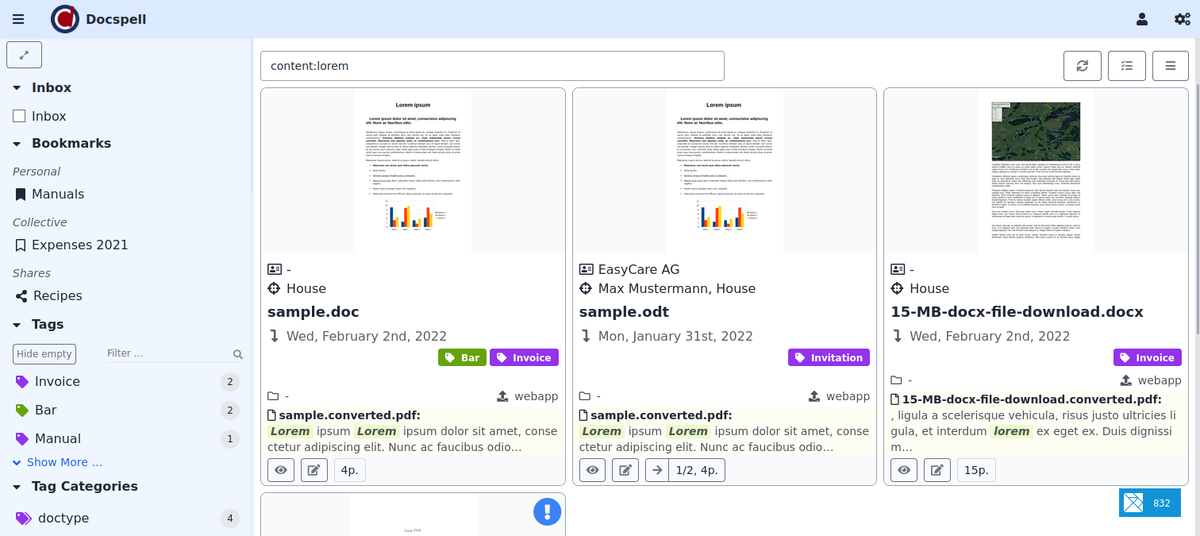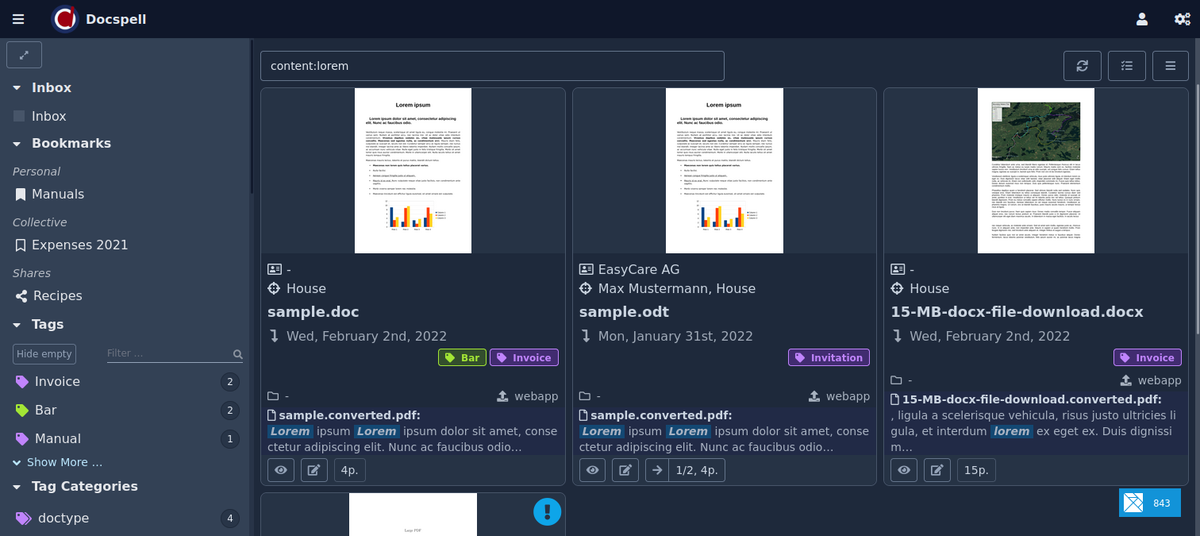Finding items🔗
Items can be searched by their annotated meta data and their contents using full text search. The landing page shows a list of current items. Items are displayed sorted by their date, newest first.
Search Bar🔗
The search bar let's you search in item and attachment names names and do fulltext search. The icon next to the search field can switch between these modes.
In the user profile, you can switch this search bar to "power search" mode. This allows then to enter complex queries.
The Names option🔗
This searches in the item name, names of correspondent organization and person, and names of concering person and equipment. It uses a simple substring search. When searching with this option active, it simply submits the (maybe hidden) search menu. So if the menu has other fields filled out, they will affect the result, too.
The Contents option🔗
Searching with this option active, there is a full text search done in: attachments contents, attachment names, item name and item notes.
If no other fields are selected, the results are not ordered by item date, but by relevance with respect to the search term. This ordering is returned from the full text search engine and is simply transfered unmodified.
Search Menu🔗


The search menu can be opened by clicking the left icon in the top bar. It shows some options to constrain the item list:
Inbox🔗
Clicking the checkbox "Inbox" shows items that have not been "Confirmed". All items that have been created by docspell and not looked at are marked as "new" automatically.
Tags & Tag Categories🔗
Click on a tag to show only items with this tag, the tag is marked with a check (✔) icon. Click again, to show only items that are not tagged with the tag. Then the tag is marked with a minus (–) icon. Clicking a third time deselects the tag and the icon goes back to a "tag" icon.
By default, the most used tags are shown and you can click on Show more… to list all. How many tags are displayed can be changed in the ui settings (go to User Settings ‣ Ui Settings).
When multiple tags are checked (✔), only items are shown that have all these tags. When multiple tags are excluded (–), then only items are shown that don't have these tags.
The same applies to tag categories. You can show all items that have at least on tag of a checked (✔) category. Or you can list all items that have no tag of a category (–).
You can also use drag&drop to tag items in this view. Simply drag an item card and drop it on a tag, this will toggle the tag on the item. If the item was tagged already, the tag is removed, otherwise added.


Folder🔗
Select a folder to only show items in that folder. Only folders where the current user has access are displayed. As with tags, there are only a few folders shown and you can expand all with a Show more link. How many folders are displayed without this link can be configured in the ui settings.
If no folder is set, all accessible items are shown. These are all items that either have no folder set, or a folder where the current user is member.
It is possible to put items into a folder in this view via drag&drop. Simply drag an item card and drop it on a folder. If dropped on the Folders header, the item is moved outside the folder.
Correspondent🔗
Pick a correspondent to show only these items.
Concerned🔗
Pick a concerned entity to show only these items.
Custom Fields🔗
You can choose one or more custom field to search for. You can use
wildcards (*) at the beginning and/or end of a search term, too. To
find items that have any value, use a single *.
Date🔗
Specify a date range to show only items whose date property is within this range. If you want to see items of a specific day, choose the same day for both fields.
For items that don't have an explicitly date property set, the created date is used.
Due Date🔗
Specify a date range to show only items whose due date property is within this range. Items without a due date are not shown.
Source🔗
This field allows to search by source id. Wildcards are supported.
Direction🔗
Specify whether to show only incoming, only outgoing or all items.
Customize Substring Search🔗
The substring search of Search in names field can be customized in
the following way: A wildcard * can be used at the start or end of a
search term to do a substring match. A * means "everything". So a
term *company matches all names ending in company and *company*
matches all names containing the word company. The matching is case
insensitive.
Docspell adds a * to the front and end of a term automatically,
unless one of the following is true:
- The term already has a wildcard.
- The term is enclosed in quotes
".
Full Text Search🔗
The Query🔗
The query string for full text search is very powerful. Docspell
currently supports Apache SOLR and
PostgreSQL as
full text search backends. You may want to have a look at SOLRs
documentation on query
syntax
for a in depth guide for how to search with SOLR. PostgreSQL also has
documentation
about parsing queries, Docspell by default uses
websearch_to_tsquery.
Here is a quick overview for SOLR queries:
- Wildcards:
?matches any single character,*matches zero or more characters - Fuzzy search: Appending a
~to a term, results in a fuzzy search (search this term and similiar spelled ones) - Proximity Search: Search for terms that "near" each other, again
using
~appended to a search phrase. Example:"cheese cake"~5. - Boosting: apply more weight to a term with
^. Example:cheese^4 cake– cheese is 4x more important.
Docspell will preprocess the search query to prepare a query for SOLR. It will by default search all indexed fields, which are: attachment contents, attachment names, item name and item notes.
The Results🔗
When using full text search, each item in the result list is annotated with the highlighted occurrence of the match.

